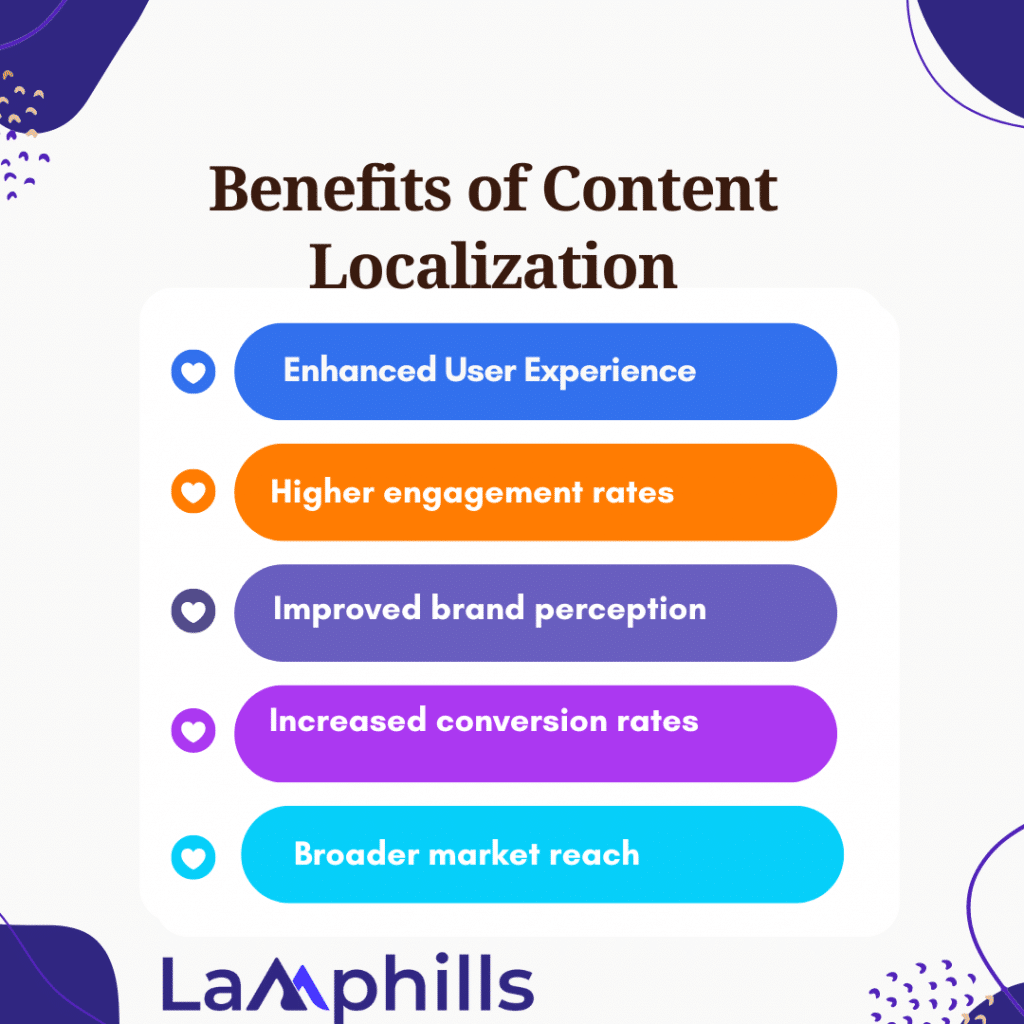When I initially started with content localization, I quickly recognized how important it was for growing our brand’s reach and resonance in many areas. Understanding the subtleties of language, culture, and local tastes made a significant difference in our foreign advertising. In this piece, I’ll reveal ten effective content localization methods from top marketing gurus that have helped us connect authentically with a varied audience.
What is Content Localization?
Content localization is the process of tailoring your content to the language, culture, and tastes of a certain target market. To guarantee that your message is understood correctly, you must have a thorough awareness of local customs, idioms, and cultural nuances in addition to translation. Successful localization may considerably enhance engagement and conversion rates, making it an essential strategy for global firms.
The Importance Of Content Localization
According to Common Sense Advisory research, 72.4% of global consumers prefer to purchase online in their native language, with 55% exclusively purchasing from websites that provide product information in their language. These findings highlight the significance of content localization in today’s global marketplace.
I recall our initial foray into content localization. We had just started a campaign geared toward the Spanish-speaking market. Initially, we just translated our English content into Spanish, but the results were disappointing. We witnessed a huge increase in engagement and conversions after including local cultural allusions, idiomatic language, and region-specific examples. This experience taught me that effective localization involves considerably more than just translation.
Read Also: Content Syndication: Ultimate Guide (What It Is, Benefits and How to Use It)
Localization makes content feel more “local” by recognizing cultural and country-specific idiosyncrasies. It may involve making any or all of the following changes:
- Spelling: Language varieties frequently have somewhat varied spellings of terms. When localizing content for a UK audience, for example, you must replace the word “localization” to “localisation.”
- Phrasing: This is especially important for content that may appear culturally insensitive or out of place to the intended audience. Humor and slang, in particular, may not work well in other languages.
- Keywords: If search engine optimization (SEO) is part of your content marketing strategy, you’ll need to research new keywords and use local search phrases in their language.
- Time and date formatting: Different countries choose distinct time and date formats. Is the local audience in your target region using MM/DD/YYYY, DD/MM/YYYY, or the 12 or 24-hour clocks?
- Measurement: Imperial and metric measurement systems are used for length and distance, weight, volume, and temperature, respectively. Your target region will determine the type of measurement you should use (such as miles or kilometers).
- Hyperlinks: When translating content into another language, look for source material written in the native language of the target audience. Assume a piece of your content refers to a news item about a recent industry development. The localized version should include a link to a related article from an industry publication in the target language.
- Photos: You may need to switch location- or culture-specific photos with others that relate to your new target market. These could include local sites, landmarks, and people from the culture to whom you are adapting your content.
- Emojis: Because the meanings of emojis differ between cultures, it is critical to utilize them in the same way that the local audience does. For example, the smiling face, which represents happiness and goodwill in the United States and the United Kingdom, represents suspicion and contempt in China.
- Right-to-left formatting: Right-to-left formatting requires layout adjustments when localizing content into right-to-left languages such as Arabic and Hebrew.
Benefits of Content Localization

Content localization provides various advantages for brands seeking to broaden their global reach and connect more deeply with diverse audiences. Here are some of the main benefits of content localization:
#1. Enhanced User Experience
Localized content resonates more with users, resulting in a more enjoyable overall experience. When content is adjusted to suit local languages, customs, and cultural allusions, consumers feel more understood and appreciated. This tailored approach results in enhanced satisfaction and loyalty.
Example: A travel business that localizes its content for Japanese tourists by using Japanese, showing popular Japanese travel destinations, and highlighting Japanese cultural events can dramatically improve the user experience. This makes the audience feel more relaxed and connected, boosting the possibility of bookings.
#2. Higher engagement rates
Content that matches local culture and language is more likely to be shared and interacted with, which increases engagement metrics. When users see content that is relevant to their cultural context, they are more likely to engage, comment, and share it with their networks.
Example: A worldwide fashion firm that customizes its social media marketing for different locations, utilizing local influencers and regional vernacular, may have increased engagement rates. For example, a campaign highlighting traditional dress during cultural events in India may receive more shares and likes than generic content.
#3. Improved brand perception
Brands may strengthen their global reputation by demonstrating respect and appreciation for local cultures. Consumers like it when firms make an effort to recognize and incorporate their cultural values into their content.
Example: Coca-Cola’s “Share a Coke” campaign, which substituted its logo with well-known names in many nations, significantly increased brand perception. Coca-Cola demonstrated cultural sensitivity and a deeper connection with customers by tailoring the experience for each market.
#4. Increased conversion rates
Localized content decreases friction in the buyer’s journey, making it easier for customers to make purchases. When information is provided in a familiar language and context, it increases trust and confidence, resulting in increased conversion rates.
Example: An e-commerce site that provides product descriptions, reviews, and customer service in the target market’s native language can experience a considerable increase in conversions. For example, offering Spanish-language support and payment alternatives customized to the Latin American market can help transactions run more smoothly.
#5. Broader market reach
Effective localization creates new markets, allowing brands to engage and connect with a worldwide audience. By tailoring content to specific locations, marketers may reach out to new customers who might otherwise be out of reach with a one-size-fits-all approach.
Example: Netflix’s strategy of generating and promoting localized content, such as original shows in local languages (such as “La Casa de Papel” in Spanish and “Sacred Games” in Hindi), has enabled the platform to achieve significant momentum in new markets. This strategy not only broadens market access but also accelerates global subscriber expansion.
10 Effective Content Localization Tips
#1. Understand local culture
Understanding the cultural subtleties of your target market is critical. This comprises not only language but also knowledge of local conventions, traditions, and social norms. Colors, for example, can have multiple meanings in different cultures. Red may indicate luck in China, yet it represents danger in Western cultures. Similarly, humor, gestures, and even the organization of information can vary greatly throughout cultures.
Expert Tip: To guarantee your content is culturally appropriate, conduct extensive studies and consult with local experts. Use cultural consultants, local focus groups, and market research reports to obtain a thorough understanding of the target culture.
#2. Use native translators
Using native translators guarantees that your content is both accurate and culturally appropriate. Native speakers can detect subtleties and nuances that non-native speakers may overlook. They grasp local lingo, idioms, and the tone that appeals to the audience.
Expert Tip: Use professional translation services with native speakers who are experts in your field. Make sure your translators are aware of your brand’s voice and style requirements. Consider using local editors to check translated content to ensure good quality.
#3. Adapt Visual Content
Visual content, like written content, needs to be localized. This encompasses photos, videos, and graphics. Ensure that the graphics are relevant and appropriate to the target audience. Cultural symbols, clothes, and even body language can have various connotations depending on the place.
Expert Tip: To make your visual content more relatable, incorporate local models, places, and scenarios. Additionally, customize design aspects such as colors, fonts, and layouts to reflect local preferences and reading patterns.
#4. Localize Idioms and Expressions
Direct translations of idioms and expressions frequently fail. It’s critical to tailor things to the local language and culture. Idioms that make sense in one language may be perplexing or incomprehensible in another.
Expert Tip: Collaborate with local copywriters to generate content that seems both natural and engaging. They can assist you in finding comparable expressions or developing new ones that will appeal to the local audience. Also, consider testing localized content with a few local native speakers to gain input before finishing.
#5. Consider local regulations
Various countries have varying rules on advertising and content. These may include limits on language use, graphics, product claims, and data privacy regulations.
Expert Tip: To avoid compliance concerns, consult with legal professionals in your target market. Keep up with changes in local rules and regulations to guarantee continued compliance. It is also advisable to work with local regulatory organizations or industry associations.
#6. Use region-specific keywords
SEO is equally crucial in localization as it is in your home market. Use keyword research tools to identify region-specific terms that your target audience searches for. Different regions may exhibit distinct search behaviors and preferences.
Expert Tip: Optimize your content for local search engines and platforms to improve visibility. Google Keyword Planner, Ahrefs, and SEMrush are all useful tools for identifying popular local search terms. Consider localizing the meta tags, descriptions, and URLs.
#7. Tailor your marketing channels
Different regions have their favorite marketing channels. In some countries, social media sites like WeChat or VKontakte may be more popular than Facebook or Twitter. The efficacy of specific types of content, such as blogs versus videos, might also differ by region.
Expert Tip: Customize your marketing strategy to focus on the channels most commonly used by your target demographic. Conduct market research to determine the most popular platforms and content formats in your targeted regions. Customize your content to reflect the unique characteristics and user behavior of various platforms.
#8. Personalize customer interactions
Personalization helps clients feel valued. Use localized data to tailor emails, recommendations, and other consumer interactions. Understanding local holidays, seasons, and events can help you create more timely and relevant content.
Expert Tip: Use CRM solutions that support multilingual and multicultural data to gain greater customer insights. Use data analytics to monitor client behavior and preferences across geographies and tailor content accordingly.
#9. Test and Iterate
Localization is a continual process. Regularly test your content and solicit input from local people to ensure continual improvement. Market dynamics, client preferences, and cultural trends are all subject to change, and your content should reflect that.
Expert Tip: Conduct A/B testing to determine what works best in different markets and then adapt your strategy accordingly. Collect data and analyze performance indicators to determine what resonates with your target audience. Update and enhance your content regularly, taking into account comments and performance data.
#10. Leverage user-generated content
Encourage local customers to develop and share content related to your brand. This not only delivers authentic content, but it also promotes a sense of community. User-generated content may include reviews, social media posts, videos, and images.
Expert Tip: Host local contests or campaigns to encourage user-generated content, and then distribute the finest submissions across your platforms. Use user stories and testimonials prominently to increase trust and engagement. This technique not only broadens your content pool but also increases consumer loyalty and advocacy.
Content Localization Checklist
Ready to take your content localization to the next level? Download our comprehensive Content Localization Checklist to guide you through each step of the process and ensure your global campaigns succeed.
Hiring Content Localization Professionals
Working with content localization pros will save you time and prevent mistakes when expanding to a new market and localizing your website.
#1. Work with Someone Who Is Native
Working with a native specialist who has lived in the culture and geographical area is essential. They may not need to live there right now, but they should be familiar with the location and its culture. This specialist will cut through any inaccurate assumptions about the location that may arise in your localization strategy.
This includes language nuances, cultural calendar celebrations, idioms, and regional sayings.
#2. Make sure they are bilingual
Finding someone who is academically proficient in a language is insufficient. They must be experts in how the language is used in a particular culture. This includes understanding colloquialisms, such as how Americans speak “soccer” and Europeans say “football” yet mean the same sport.
Idioms and sayings are extremely significant in any culture because you don’t want to insult people while also coming across as knowledgeable. Having a translator is not enough.
#3. Hire a Content Localization Expert to Increase Credibility
Hiring the right person will improve the credibility of your content. If your content is awkward or even insulting, you will face significant challenges when attempting to reach your target audience. This is important for both written and multimedia content. Why would a potential consumer listen to your advice or recommendations if you don’t understand how they dress or interact with one another?
#4. A Content Localization Expert Builds Trust
The right content localization professional will understand how to establish trust with your audience. When developing content, your expert will use their skills to begin small and establish connections with your target market. They will present your content in such a way that reading or viewing it allows your audience to unwind and sigh with relief since it is a good match. This will motivate them to discover more, propelling them farther down the marketing funnel.
#5. Outsourcing content localization saves both time and money
If you are growing into new geographical areas with localized markets, you can save time and money by outsourcing a portion of the process. Content developers, authors, translators, photographers, and videographers might be engaged for specific jobs or target markets.
Because you are new to this market, you will need to start with a larger package of localized content. After establishing a routine, you will require fewer pieces of localized content in the future. This type of work is ideal for outsourcing. You will receive access to content localization experts, whom you can use as needed for marketing and other initiatives.
#6. Outsource to content experts with a strong reputation
When outsourcing content development for your new market, choose a provider with a solid reputation. It should be a reputation earned over time through good work for a variety of clients. Read reviews of their previous efforts in content localization. Have a peek at their blog articles and website.
Next, assign a test assignment to check if you like how they function. Be realistic in your expectations. The best freelance content localization company will not be the cheapest or quickest. They will demonstrate their expertise in every encounter and piece of content they create for you.
If you want to establish trust and reputation in your new local market, hire the best individuals from the start. Consider the disaster that could occur if you start your connection with quick, inexpensive content. That will only turn potential buyers away.
#7. Where to Begin?
While content creators who are dependable, economical, and competent with localization appear to be omnipresent, you shouldn’t believe everything you read in advertisements. Conduct research to identify the ideal localization partner for expanding into each new market.
Here are some content localization professionals that we recommend.
- WriterAccess: WriterAccess is one of the leading makers of online content in general, and it is quickly becoming the best place to outsource worldwide and localized content. When it comes to localizing content for your target audience, you can work with a single writer, a team of writers, or a random writer.
- Upwork: Upwork is a marketplace where you can look for content localization professionals or form teams for projects.
- Neil Patel: Neil Patel is a well-known SEO and digital marketing guru, who also specializes in creating localized content.
Key takeaways
- Deep cultural understanding is required to develop content that resonates while avoiding cultural pitfalls.
- Native translators provide accuracy and cultural relevance by capturing nuances that non-native speakers may overlook.
- Localizing visual content, such as photographs and videos, is essential for producing relatable and engaging content.
- To avoid legal concerns and develop confidence with your audience, ensure that you follow local laws and norms.
- Encourages local customers to produce and share content, which promotes authenticity and community.
Conclusion
Effective content localization is a great strategy for connecting with global audiences while increasing engagement and conversions. Understanding local culture, hiring native translators, customizing visual content, and taking into account local legislation can allow you to develop content that resonates profoundly with your target markets. Are you ready to take your content to the next level using these effective localization tips? What problems have you encountered during your localization efforts? Share your experiences and let’s learn from one another!
Related Articles
- 30+ Best Guest Blogging Sites to Submit Your Content in 2024
- What is Content Syndication and Why You Should Start Using It Today
- The Biggest Content Personalization Mistakes You’re Probably Making (And How to Fix Them)
- Short Form Content Mastered: Insider Secrets for Creating Viral, Money-Making Posts
- The Ultimate Guide to Effective Content Monitoring for Maximum Results






